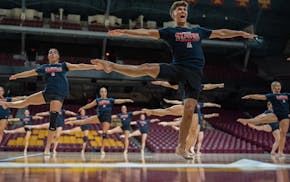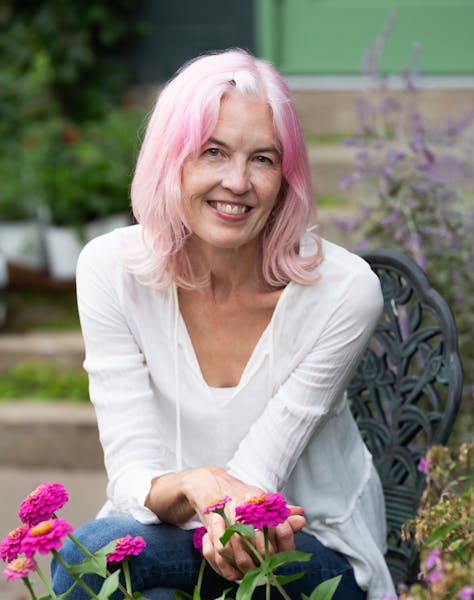The sight of Ryan Hamilton learning to ice skate at age 40 could melt the most stoic of Minnesota hearts.
His arms outstretched, he chops his way across the rink on hockey blades, only his third time ever on ice. Instead of watching from a distance as his children try new things, it is Hamilton, a father of two, who bears the steely look of determination as he awkwardly steps toward acquiring a strange and foreign skill.
His kids, Gus and Sophia, 5 and 3, look on from the bleachers, waving and smiling at Daddy. Hamilton grins and waves back.
He starts to scooter-push one leg and suddenly finds his momentum — as well as a gleeful spark that he doesn't even try to conceal. "This is the most fun I've ever had on ice!" he tells his instructors.
For anyone who ever thought the joy of learning was strictly for kids, adult beginners like Hamilton prove us wrong. "They inspired me," says Hamilton of Crystal, who decided to take lessons for himself after signing up his children. "I don't want them to be having all the fun at the neighborhood pond rink. Let me learn so I can play, too."
I met Hamilton and a handful of other beginner ice skaters at the New Hope Ice Arena, where some of the most dramatic game moments of "The Mighty Ducks" movies were filmed. In a hockey-obsessed state like Minnesota, you frequently hear of toddlers who've gotten up on skates as soon as they learned to walk. Sometimes at your local indoor rink, you'll see not only tots in helmets and mittens practicing a snowplow stop, but grown adult students shuffling — and tottering — on the ice.
"It's generally thought of as a sport that you need to learn when you're 3 years old, but it's really not," says Jeri Joy, one of Hamilton's instructors.
It's never too late.
Tips for beginners
Many adults learn because they want to be able join their kids on the ice. If swimming is a necessary summer skill in the Land of 10,000 Lakes, think of skating as its winter counterpart in the State of Hockey. Yet there are obstacles to learning to skate in one's later years. And the lessons may apply to life in general.
"As you get older, falling is not something we enjoy," Joy says. "There's a fair amount of falling in ice skating, so we need to get over that."
Don't fight the fall, she advises. She teaches students to land on their bottoms. To get back up, find your way to your hands and knees. With one knee planted, bring the other foot up on the ice, followed by the other.
"The first thing I always want adults to know is: Relax," says Molly Olson, another New Hope instructor. Adults tend to stiffen up, especially in the legs, making it harder to balance because they're bending at the waist, rather than in the knees.
I take mental notes, though I'm not exactly a beginner. My childhood home in the Chicago suburbs backed up to a retention pond, and I remember lacing up my Care Bears double- blade ice skates as soon as the pond froze. Still, I would put my skating abilities today as just a notch above "not likely to break a hip."
I have Minnesota-born-and-raised friends who seemed like normal humans until I shuffled beside them on skates. The first time we met up at a skating party (at their neighbor's homemade ice rink, like a postcard of wintertime in Minnesota), they swooped by me — forward, backward, crossover — revealing a latent superpower that they never bothered to mention.
Here's why I admire adult beginners like Hamilton: Many of us grown-ups don't put ourselves out there. We can't be talked into trying something we might be terrible at, for fear that we finally expose ourselves as uncoordinated, unathletic or dumb. In doing so, our pride stops us from experiencing the thrill of being a beginner. Parents, especially, so eager to chauffeur their kids to skateboarding camps, chess meets and violin lessons, take a back seat to their own potential opportunities for joy.
Which is why I want to high-five Stephanie Stover of Golden Valley, another parent in the New Hope ice skating class. She grew up skating in her native France, but trying it again in middle age made her realize "it's not like riding a bicycle," she explains. "I don't know what's happening to my body, but I have no balance anymore. It's like I'm ice skating for the first time again."
But her kids are teens now, and she's no longer shuttling them to dance or gymnastics.
"My daughter can drive now, my son has his own thing," she says, "and I think it's time for me to do my own thing, too."
Hamilton grew up playing basketball and running track in his home state of South Carolina, a place known more for its palm trees than pond rinks. Yet the athleticism of ice hockey always fascinated him. Now that he's been in Minnesota for a decade, he says he's realized that one needs to find ways to endure, and even enjoy, winter.
"To be a transplant, especially from the South, you've got to embrace the cold-weather activities," he says.
He bought a new pair of skates last winter, hoping he could eventually play hockey with his kids at the neighborhood rink, but "that didn't work out so hot," he recalls. He tumbled down left and right.
But now Hamilton senses progress. After his lesson, sweat trickles from his brow. "I'm gonna get this," he says with a laugh.
As for his new hobby? There is lots to love, and he counts the ways.
"It's a good workout. It's a way to stay active as an older person. And it's low-impact," he says. "Except for the falling."
Yuen: How success has pushed Minnesotans off sidelines in trans athlete debate

Yuen: When cancer struck a second time, she found 'euphoria'

Yuen: The University of Minnesota's first male dance team member is turning heads by staying real
Yuen: How George Floyd's aunt healed her heart and lent her voice for justice






